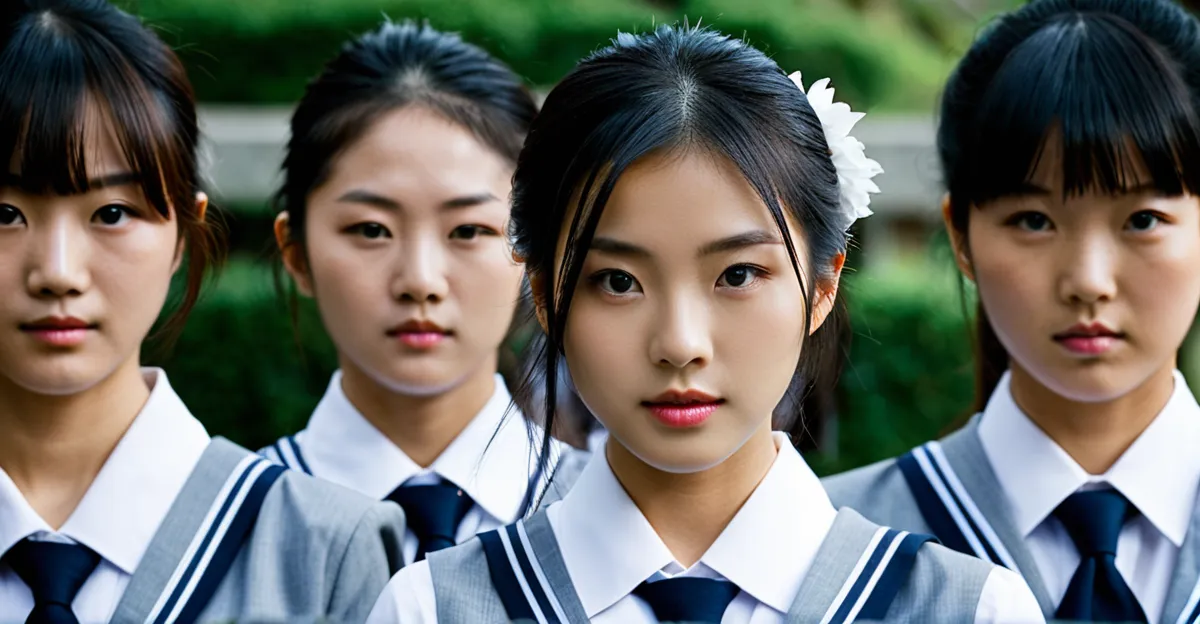Japanese school uniforms blend tradition and modern style, reflecting a rich history and evolving social values. From classic sailor suits and gakuran tunics to contemporary gender-neutral designs, these uniforms capture cultural identity while offering practical, fashionable options for every occasion. Their unique features reveal shifts in youth expression, inclusivity, and school life, making them more than just attire—they’re a symbol of Japan’s changing society.
School Uniform Culture: Rules, Personalization, and Societal Perceptions
Dress codes, enforcement, and common ways students personalize uniforms
Student dress regulations in Japanese schools remain clear and binding, with strict school uniform etiquette ensuring that core elements—such as pleated skirts, sailor suit style tops, and blazers—retain a standard appearance. Most schools specify details for girls school attire and boys school outfits, regulating skirt length, blouse design, and ribbon or tie colors. Enforcement can be rigorous, particularly at public ceremonies, but many students find subtle ways to express student fashion expression within uniform rules. Typical personalizations involve unique socks, loose neckties, playful hair ribbons, or attaching small charms to official Japanese schoolbag types. Nonetheless, visible rule-breaking (like excessive skirt shortening) may result in extra inspections or disciplinary action.
Also read : Elevate Your Boho Chic Look: Stylish Ways to Wear a Paisley Shawl in Brighton
Uniforms in youth culture, subcultures, and media (anime, manga, and pop culture trends)
The cultural significance of uniforms is evident in anime, manga, and street fashion, where seifuku designs symbolize youth identity. The sailor suit style has iconic status, fueling cosplay events and recurring school uniform trends globally. Adaptations of Japanese school uniforms anime influence real students’ choices, from ribbon and necktie types to uniform accessories. Subcultures reinterpret uniforms—kogal, sukeban, and others—using altered lengths or color combinations as statements of individuality.
The role of uniforms in shaping school identity, social attitudes, and discipline
School uniforms influence more than outward appearance; their effects on student identity and cohesion are widely recognized. Many student opinions on uniforms reflect pride in belonging, while parents’ views on uniforms highlight issues of equality, practicality, and school spirit. Ongoing uniform policy debates examine how standards support discipline, reinforce social attitudes, and contribute to a respectful learning environment. Uniform public perception remains shaped by Japan’s emphasis on tradition and collective harmony, but now includes consideration for gender inclusivity and evolving cultural norms.## Access, Market, and Practical Considerations for Japanese School Uniforms
Also to see : Complete your look: the best steampunk outfit ideas and accessories
How and where to buy authentic and cosplay Japanese uniforms, including price ranges and brands
Authentic Japanese school uniforms, like the iconic sailor suit style and seifuku designs, are widely available through online shops for schoolwear and specialty cosplay stores. Major platforms, such as https://kimurakami.com/collections/japanese-school-uniforms, provide a selection of sailor fuku and gakuran jackets, with prices ranging from about $44 for basic items to nearly $100 for deluxe high school dress codes. These uniform manufacturer brands also offer girls school attire and boys school outfits with options for personalized fit and fabric preferences. Both traditional uniforms in Japan and contemporary high school uniform types are accessible year-round.
Guidance on maintenance, care, and seasonal switching of uniforms
Proper upkeep ensures school uniform costs remain manageable. Uniform maintenance tips focus on gentle washing of pleated skirts and summer uniform variations to preserve fabric and color. Seasonal uniform switches, such as moving from light cottons in summer to heavier winter uniform styles, are routine in Japanese high schools. Storage of off-season seifuku designs and blazers in breathable garment bags helps prolong their lifespan. Students routinely change ribbon and necktie types, socks, and uniform footwear according to weather and school dress regulations.
The impact of Japanese school uniforms globally, in cosplay, and international fashion trends
The influence of sailor suit style and other Japanese school uniform elements extends far beyond Japan’s classrooms. Cosplay school uniform options allow fans of school uniforms as seen in anime or manga to engage with the cultural significance of uniforms, boosting interest in customized uniform options abroad. International fashion trends often borrow pleated skirts, uniform accessories, and even schoolbag types from Japanese high school dress codes, inspiring online shops for schoolwear worldwide. This ongoing uniform fashion influence demonstrates the lasting appeal and versatility of Japanese school attire.
Essential Features, Evolution, and Cultural Meaning
Across Japanese culture, the Japanese School Uniform is woven into the daily experiences of students, embodying a complex mix of history, identity, and social expectation. The first uniforms arrived during the late 1800s, driven by the Meiji government’s wish to modernize education by shifting from kimono and hakama to Western-inspired dress. Since then, each era—from postwar reforms to today’s schools—has left its mark on fabric, style, and regulations.
Uniform symbolism remains strong. For many, the outfit signals a new stage of life, representing discipline and shared belonging. This is especially true at the high school level, where students don the classic sailor fuku or the formal gakuran, both holding deep cultural roots. Uniforms tie individuals to a cohort but also become the canvas for student creativity: subtle skirt length changes, adjusted collars, or choice of socks offering hints of personality even amid strict uniform regulations in Japan.
A clear distinction exists between elementary and high school attire. Elementary students, especially in public schools, often have no uniform or simpler, practical versions. In contrast, Japanese high school attire tends to be more elaborate and symbolic, with pronounced gender differences in uniforms—pleated skirts and sailor collars for girls, blazer jackets or traditional stand-up collars for boys.
Fashion cycles influence schoolwear too. Iconic visuals from anime, televised dramas, and youth magazines have cemented the school uniform as a pop icon. This media presence fuels ongoing debates about cultural significance of uniforms, inspiring both nostalgic reverence and resistance in youth subcultures. As a result, schools now balance classic motifs—like school emblem patches and iconic neckties—with the steady rise of genderless or unisex options, reflecting changing norms in 2025.
Distinct seasonal uniform changes occur: lighter fabrics, softer colors, and short sleeves define summer, while heavier materials, darker tones, and layering with sweaters or vests signal winter. Color and detail variations reinforce each school’s unique identity while reinforcing unity. Ultimately, these uniforms act as both a rite of passage and a lasting emblem of student life, continuing to evolve with society.
Key styles, structure, and components of Japanese school uniforms
Sailor suit style (seifuku): design origins, typical elements, and variations for girls
In Japanese high school attire, the sailor suit style—called seifuku—stands out through its unique blend of tradition and practicality. Anchored by sharply defined uniform collar types, this iconic look features pleated skirt lengths that vary by school and season. The standard pairing is a crisp blouse with sailor-inspired collar, combined with a pleated skirt, and completed with school emblem patches or subtle embroidery. Iconic necktie styles and ribbon choices signal class, school, or specific student age groups and uniforms. Seasonal uniform changes affect fabric thickness: lighter materials for summer, wool blends or lined garments for winter uniform designs. This sailor suit style remains a staple for junior high, with some high schools retaining it to maintain continuity.
Gakuran and blazer jackets: classic male uniforms and the shift toward Western-inspired attire
For males, Japanese high school attire often centers on traditional blazer jackets and the gakuran. Traditional blazers are typically navy or black, structured, and paired with school emblem patches for clear identification. As Japanese school uniform symbolism evolved, gender differences in uniforms became less pronounced, especially with the increasing adoption of gender-neutral blazer options in some schools. Seasonal uniform changes—such as thicker winter uniform designs and cooler summer versions—reflect comfort priorities across the school year.
Notable components: collars, ties, ribbons, pleated skirts, emblems, and accessories
Uniform collar types and pleated skirt lengths consistently help categorize uniforms by formality, student age, and academic level. Iconic necktie styles, ribbons, and a variety of uniform accessories such as pins or socks foster both school pride and subtle individuality. In media, famous uniform designs in media—especially those portrayed in anime—highlight distinctive color patterns, school emblem patches, and the reliable, stylish influence of traditional Japanese uniforms.
Seasonal Adaptations, Gender-Neutral Options, and Contemporary Trends in Uniform Wear
Summer and Winter Uniform Designs, Material Choices, and Occasional Layering
Japanese high school attire adapts noticeably to the climate, prioritizing comfort and regulation. Summer uniform fabrics such as breathable cotton blends and lighter polyester are common, emphasizing easy movement and ventilation. In contrast, winter uniform designs employ heavier wool or acrylic knits and double-layered materials. These seasonal uniform changes often include thicker jackets and vests. To manage shifting temperatures, students rely on uniform layering techniques—adding sweaters or scarves for extra warmth. Choices between summer vs winter gear directly impact uniform comfort features and student satisfaction.
Genderless and Customizable Uniform Trends Since 2019
Recent years have seen a rise in gender-neutral uniform options in response to evolving societal views. Many schools now permit students to select items regardless of gender, reducing traditional gender differences in uniforms. The possibility to adjust skirt and trouser lengths illustrates ongoing uniform customization and a commitment to inclusivity. Flexible dress codes have widened the appeal of traditional patterns, blending classic elements with fashion adaptations of uniforms.
Current Student Adaptations, Personal Expression, and Rising Popularity of Fashion or Cosplay-Inspired Variants
School uniform popularity trends continue to shift, partly influenced by anime school uniform influence and cosplay culture. Students increasingly incorporate fashion adaptations of uniforms, such as mixing custom accessories, badges, or playful modifications to pleated skirt lengths and collars. These updates support personal identity within the student community, reflecting the evolving role of uniforms in Japanese culture.
Where to find, shop, and style Japanese school uniforms today
Best sources for authentic and cosplay uniforms, price ranges, and top brands
Uniform shopping places for both genuine Japanese school uniforms and cosplay variations now range from specialty boutiques to dedicated online platforms. Stores like KimuraKami focus on traditional gakuran jackets, Japanese high school attire, and classic sailor suit style sets, as well as uniform-inspired fashion. Popular uniform brands lead the market by offering attire reflecting both historical evolution of uniforms and current school uniform popularity trends. Prices depend on fabric types used and intricacy—authentic Japanese high school attire may start under $70 and reach $130, while cosplay and uniform resale and secondhand market options provide accessible alternatives. Uniform costs fluctuate by season, with discounts especially during school uniform shopping seasons.
Tips on caring, maintaining, and styling Japanese uniforms for daily or cosplay use
Uniform maintenance tips emphasize preserving uniform color variations and ensuring proper fit. Gentle uniform fabric care such as hand washing or using garment bags prevents damage to pleated skirt lengths and iconic necktie styles. For styling, consider uniform accessories including school emblem patches, stockings, and personalized bows or ribbons. Uniform customization, especially for cosplay and uniforms, is popular—students often tailor jackets for seasonal uniform changes or mix pieces for after-school wear, balancing dress codes for students with personal aesthetic.
Influence of anime, media, and subcultures on modern uniform trends and photography ideas
Anime school uniform influence and modern uniform trends fuel school uniform symbolism in current youth fashion. Uniform-inspired fashion draws upon sailor suit style and the perception of uniforms in society, such as televised dramas and manga. Cosplay and uniforms used in themed events or photography highlight the cultural significance of uniforms, while school uniform photography offers creative concepts—for example, adapting layering techniques for seasonal looks or capturing famous uniform designs in media against nostalgic campus backgrounds. These styles transform student identity and uniforms into symbols of both self-expression and communal pride.





